Excursion to the Jurassic Museum of Asturias. Fun watching dinosaurs (ENG-ESP)
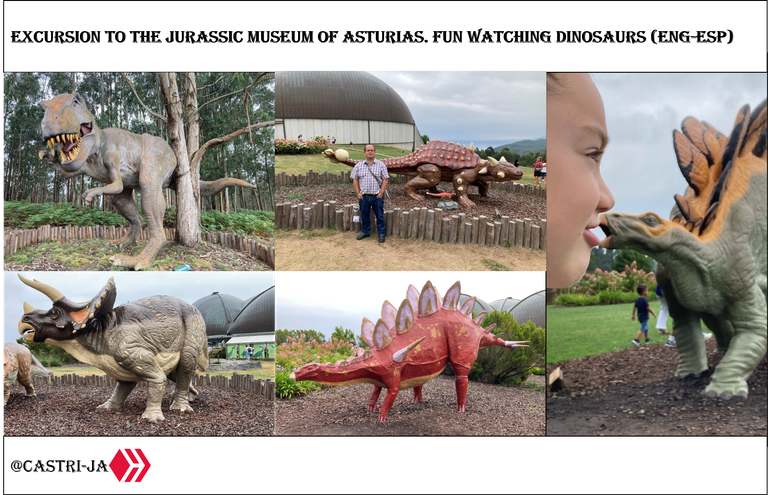
English
I hope you are having a good end of the week #Hive friends and #pinmapple community.
Last week, because my cousin and her parents were at the family home on vacation, we decided to take the opportunity to visit about 120 kilometers from home the Jurassic Museum of Asturias.
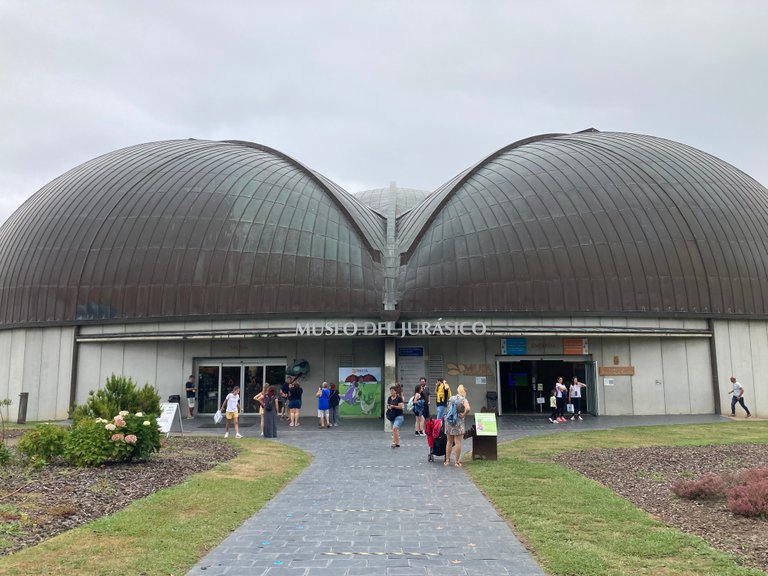
This museum present in the outside of the museum, there are 16 sculptures (some doubles) of the main dinosaurs and my goal was to walk all around to photograph them all and be able to share it with all of you. An important issue, which may be of interest to those who have children and their economy is a little tight, is that the outside is free all year round and on Wednesdays access to the inside of the museum is free, only in the summer months due to the large influx of visitors you have to wait a long time to access or make a reservation in advance online.
Focusing on the theme of the outdoor sculptures, I leave a photograph of each dinosaur in the order in which I found them in the park surrounding the museum and in turn I write a short review of each of them after reading the information there is for each dinosaur on the websites https://www.dinosaurios.info/ and https://prehistoria.fandom.com
Diplodocus
This sculpture is the first to be found when entering the museum on the left side. It is the sculpture with the longest length. Until a few years ago it was considered the largest dinosaur in history. But in 2014, the Patagotitan fossils discovered in Latin America, dethroned it from being the largest dinosaur in history. This type of dinosaur, according to the information I have found, had a length of about 54 meters and weighed over 110 tons.
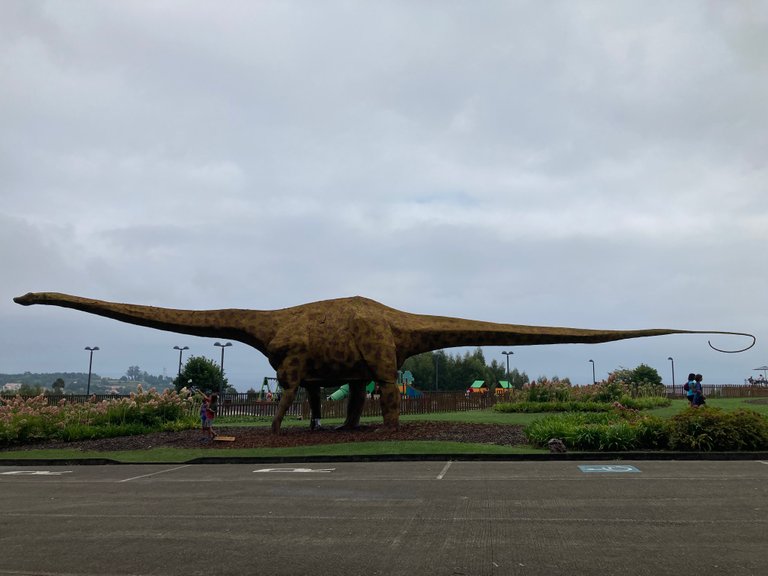
Tyrannosaurus Rex
What child or adult is not or has not been a fan of the fearsome king of the dinosaurs?
This dinosaur had a great ferocity, since with its jaw it was able to exert a force of 3,000 kg. As a curiosity, their brains were twice the size of other larger predators, which gave them great intelligence for hunting.

Of the genus Tyrannosaurus, apart from the feared Tyrannosaurus Rex, this museum has a model without the surname of Rex, I guess it is because in the paleontological world there are already defined several types of tyrannosaurs apart from the popular Rex.

Stegosaurus
This herbivorous dinosaur was smaller than other herbivorous dinosaurs. It presents as a characteristic some spikes along its back that served as a defensive form against predators. In particular, this sculpture I loved the position of its mouth and with a little patience I could play with the perspective and with the help of my cousin I could take a nice and tender picture.


Pteranodon
It is one of the most popular flying reptiles that appears in all the Jurasic Park movies. Its dimensions could reach up to 7 meters in wingspan. One of the points that caught my attention was the detail of the eggs and a small Pteranodon that was breaking the egg.
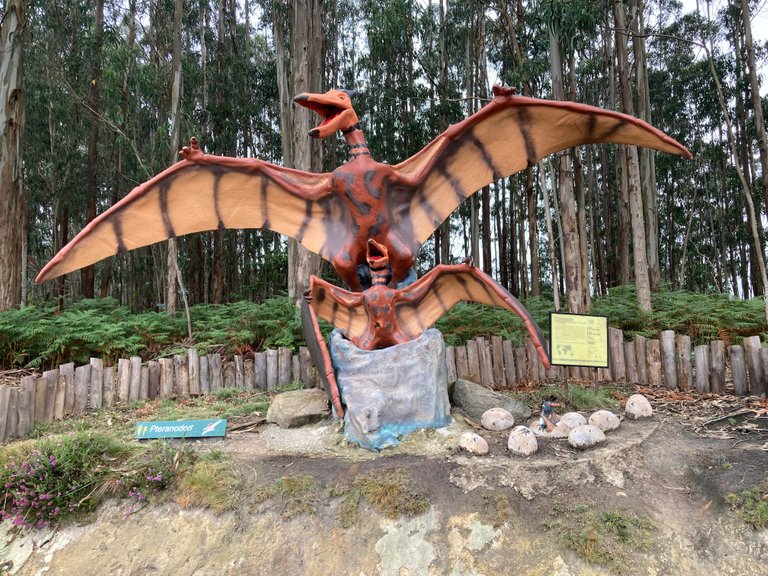
Parasaurolophus
This type of dinosaur caught my attention because of its crest and its mouth similar to the one that ducks have nowadays. The information of the web indicates that it is a herbivorous dinosaur of about 3.5 meters high and about 5 tons of weight.
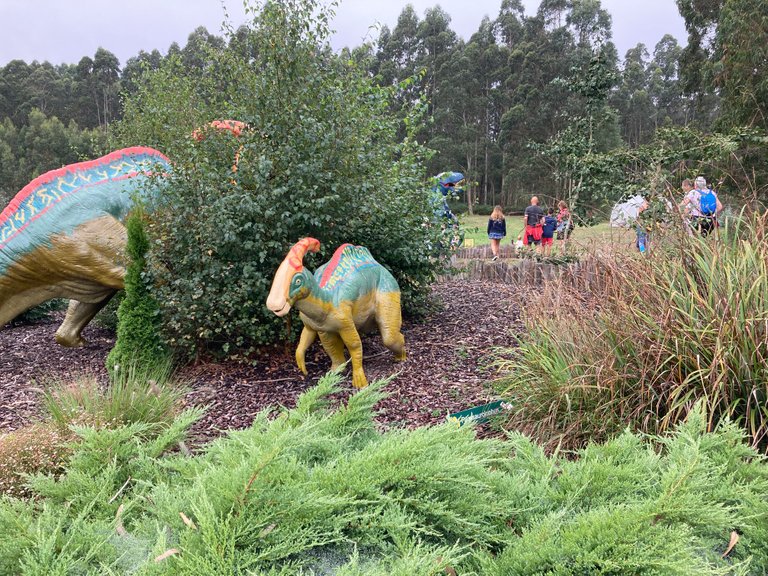
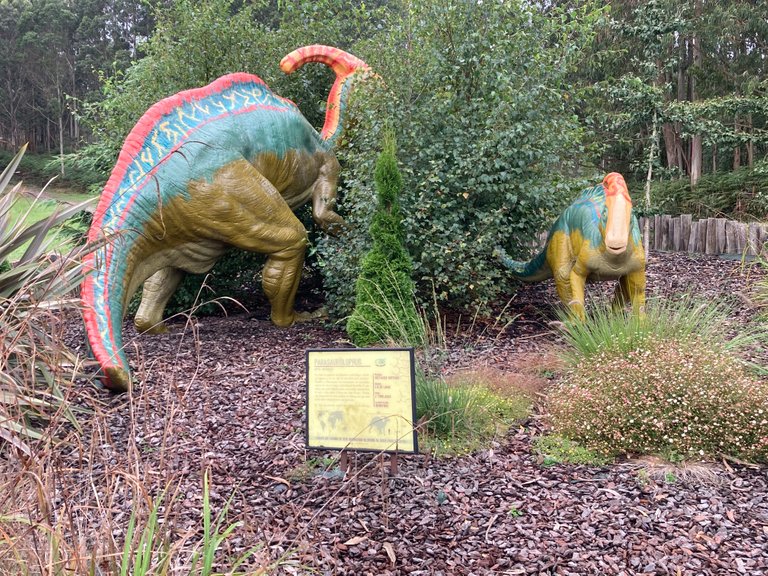
Triceraptos
I think it is my favorite dinosaur; even ahead of Tyrannosaurus Rex. It is one of the herbivorous dinosaurs and with its powerful horns I imagine it must have intimidated its predators. In the vicinity of the museum, in addition to the sculpture of the triceraptos is a life-size model of what would be a head of this wonderful dinosaur.
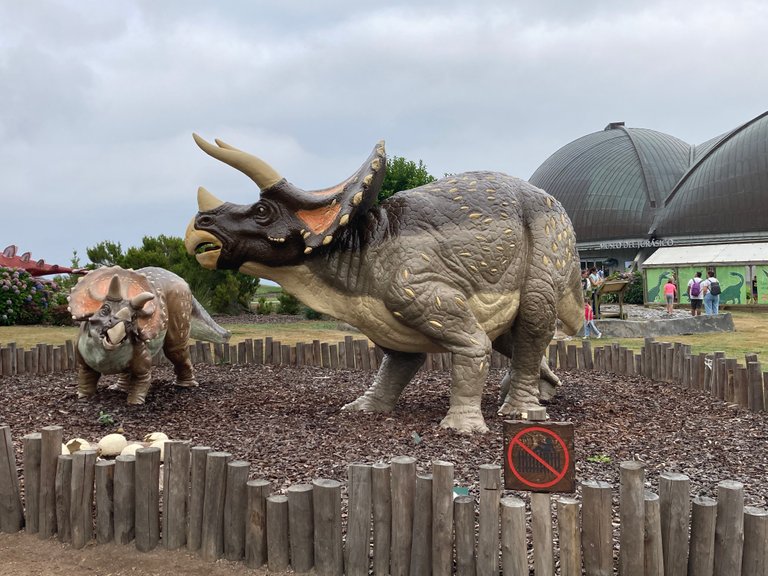
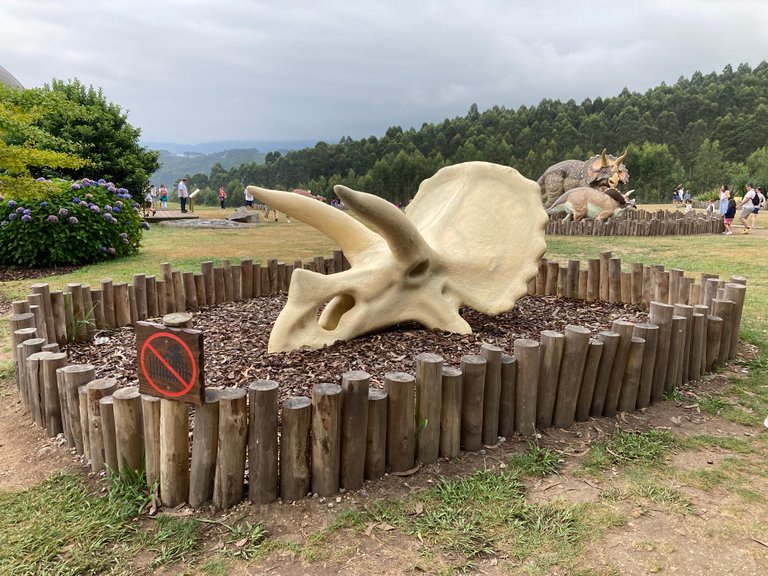
Pachycephalosaurus
This dinosaur delighted my cousin and from what she can hear from other visitors to the museum. Its appearance in which it looks like it has an egg as a helmet made many visitors spend a long time observing it. According to the information on the website, it is a dinosaur that is debated whether it was herbivorous or omnivorous, of which there are few fossils, which have generally been found in North America.
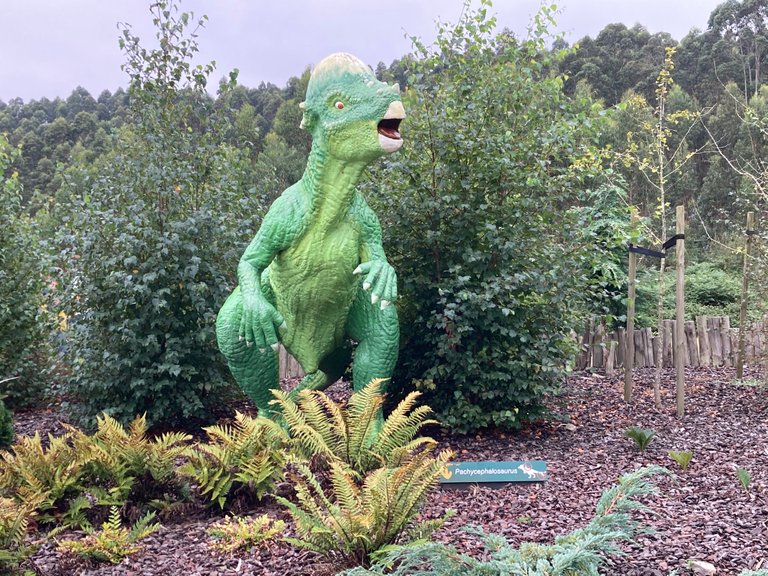
Carnotaurus
It has two horns on its head. It was 9 meters long and weighed 2 tons. Carnivorous feeding. These horns are small compared to those of a Triceraptos, so I do not think they were used during hunting or for defense.
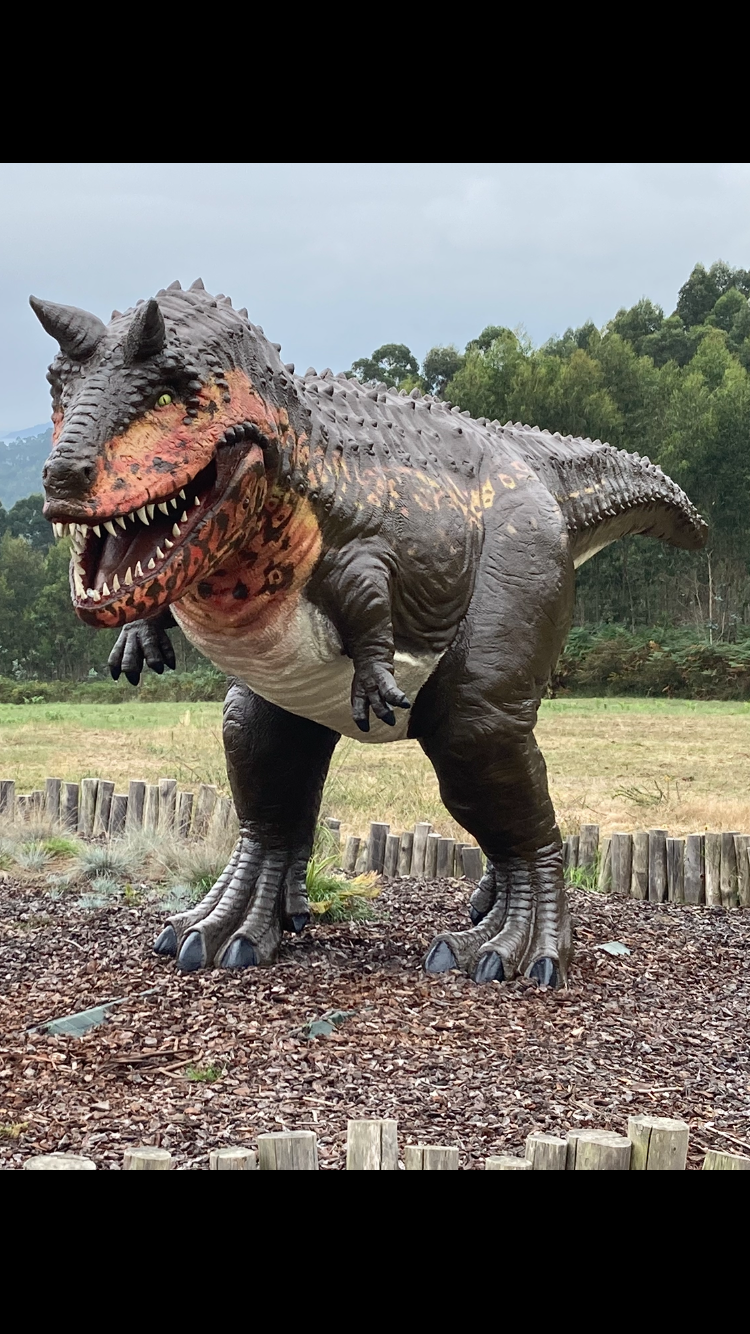
Oviraptor
It is a small dinosaur. Usually smaller than a human. According to the pages I have consulted, this dinosaur is native to Asia and was considered an egg thief, but there is no evidence of this in the fossils found.
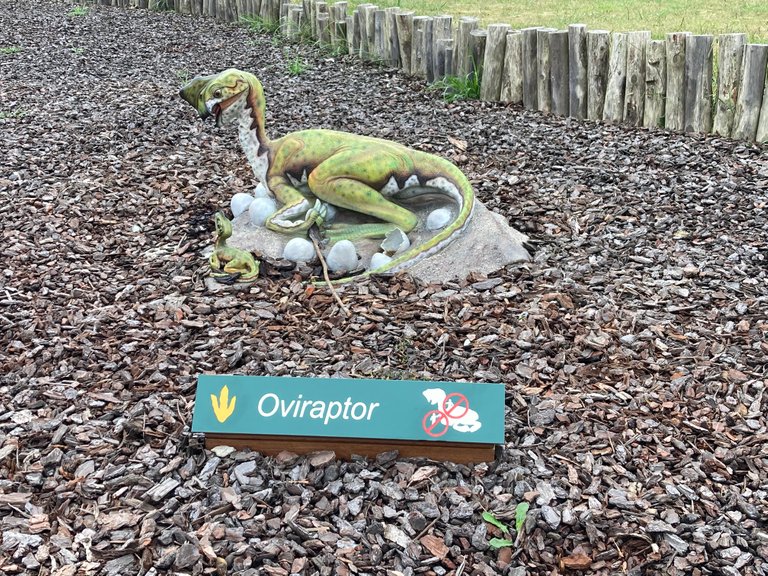
Deinonychus
I was very struck by its large claws on both front hands and feet. When I looked for information on the internet, they just referred to this information about the claws. In fact, its name means terrible claw.

Euoplocephalus
With this dinosaur I asked my aunt to take my picture. I think her countenance made me laugh and so I wanted to take a picture with this colorful dinosaur that has a multitude of horns and powerful ball-shaped defenses on its tail. I am sure that predators would think twice before attacking this herbivorous dinosaur.
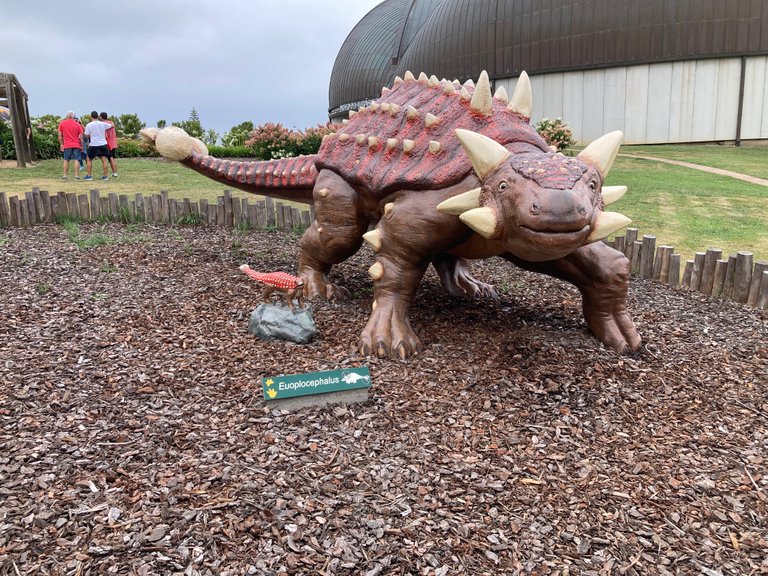
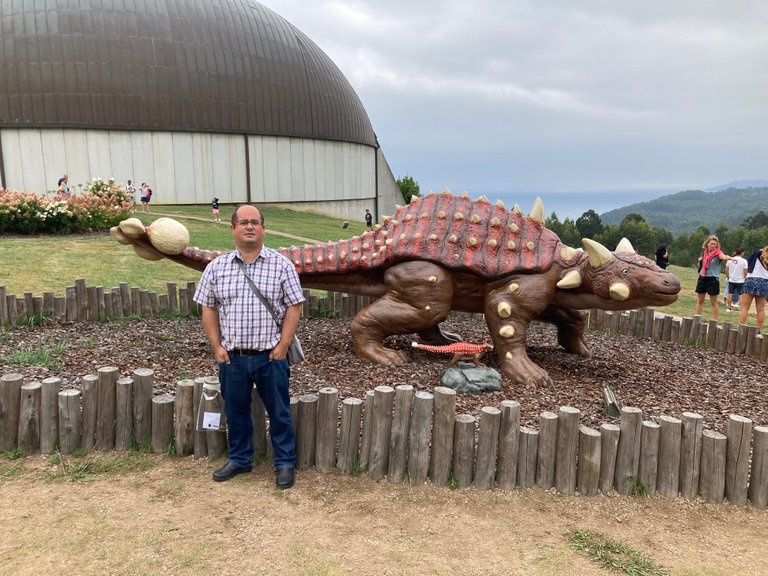
Camptosuarus
This dinosaur is found near the entrance door to the museum building. According to the information on the websites, it was a very peaceful herbivorous dinosaur whose main defense was its ability to move faster than other dinosaurs to escape from predators.
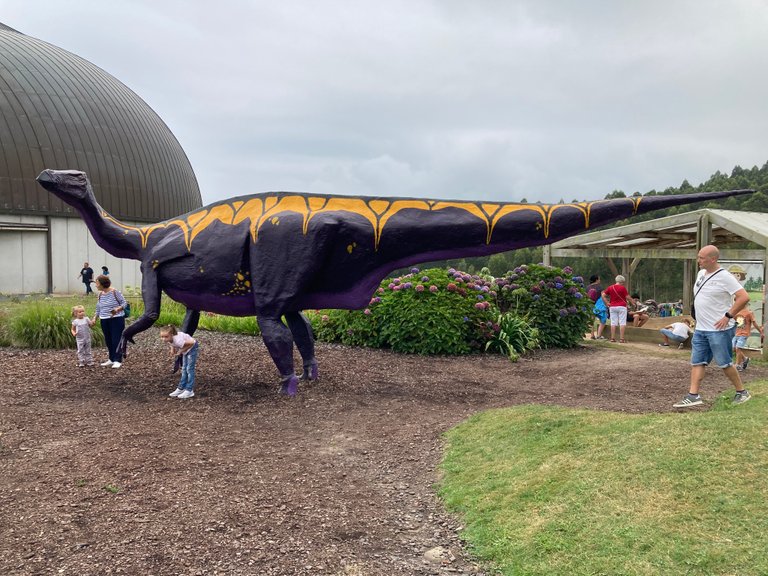
Dacentrurus
Its morphology is similar to that of Stegosaurus, with horns on the tail, part of the back and shoulders. What a great defense for the carnivorous dinosaur that wanted to sink its teeth into it.

Allosaurus
Another carnivorous dinosaur and like all carnivorous dinosaurs, it walked on two legs. Its size was smaller than the Tyrannosaurus Rex, but according to the pages consulted, it dared to face large herbivores, hunting large diplodocus in groups of two or three individuals.
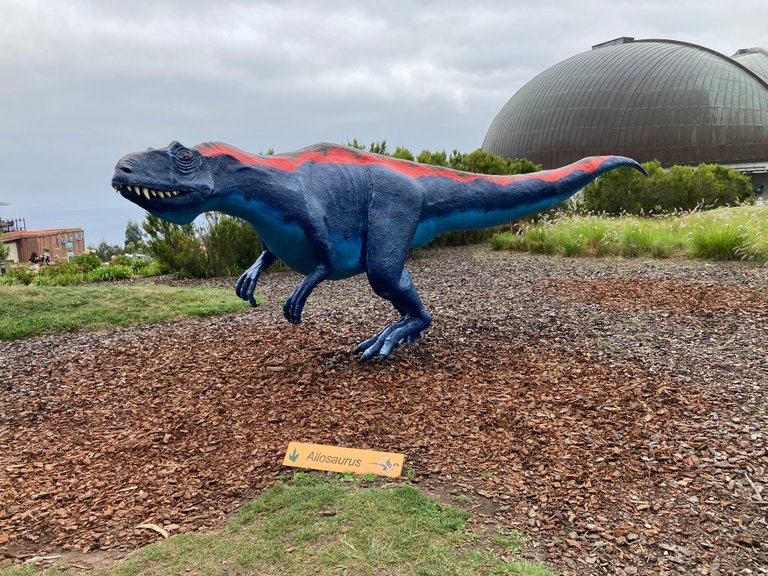
Brachiosaurus
This type of herbivorous dinosaur was a constant point of attraction during the visit. The museum installed a small dinosaur so that the little ones could climb on top of it and take a souvenir photo.

In addition to these statues of the main land dinosaurs, in the vicinity of the entrance to the museum building there are several replicas of the footprints found in 3 enclaves of Asturias near the museum:
- La Griega beach in Colunga
- Tereñes I in Ribadesella
- Tereñes II in Ribadesella
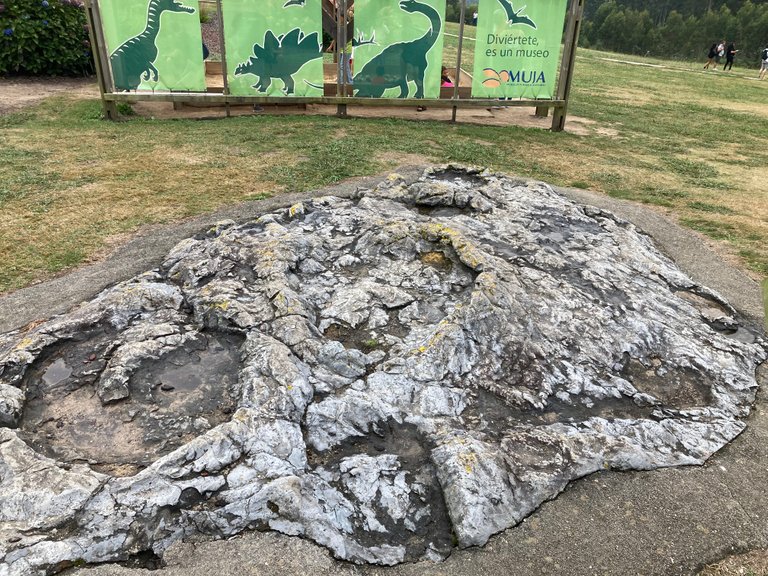
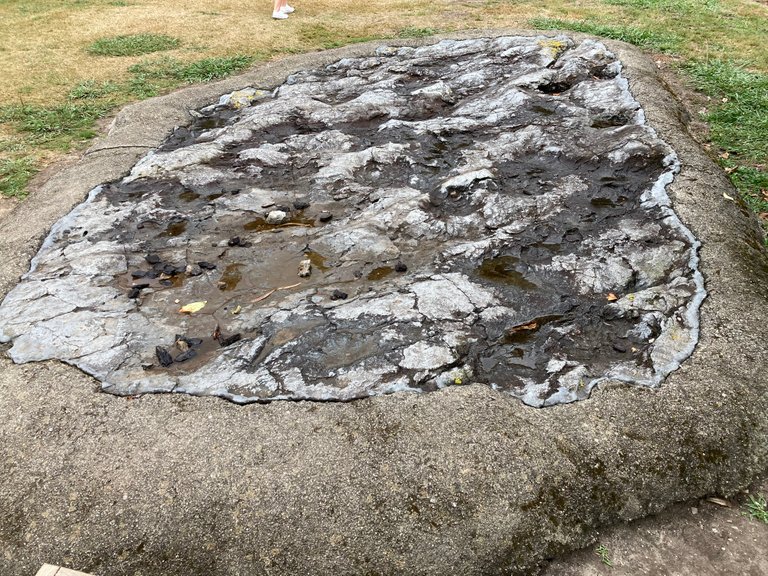
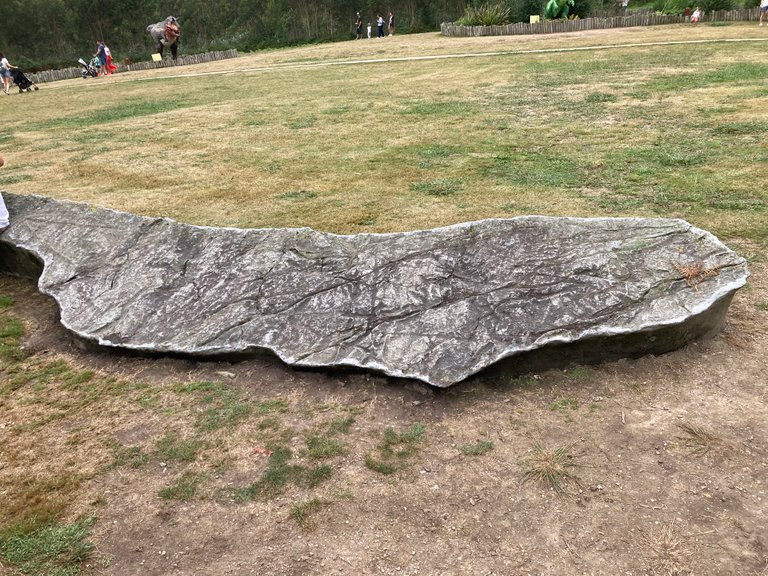
Due to the fact that I visited on a Wednesday, the capacity to access the interior was full, so I will have to visit again and I will do it outside the vacation season to ensure the access.
I loved this visit and even more when to write this post I have been reading information about dinosaurs to be able to write some curiosities about some of these great lizards.
I hope you liked this tour through the Jurassic.
Best regards.
Original photos taken with my iPhone SE.
Cover created with Microsoft PowerPoint.
Translated with www.DeepL.com/Translator (free version).
Español
Espero estén teniendo buen final de semana amigos de #Hive y de la comunidad de #pinmapple.
La semana pasada, debido a que mi prima y sus padres se encontraban en la casa familiar de vacaciones, decidimos aprovechar para visitar a unos 120 kilómetros de casa el museo del jurásico de Asturias.

Este museo presente en la parte exterior del mismo, hay 16 esculturas (algunas dobles) de los principales dinosaurios y mi objetivo fue recorrer todos los alrededores para fotografiarlos todos y poder compartirlo con todos ustedes. Un tema importante, que puede ser de interés para aquellos que tienen niños y su economía esté un poco ajustada, es que la parte exterior es gratuita todo el año y los miércoles el acceso al interior del museo es gratuito, solo que en los meses de verano debido a la gran afluencia de visitantes hay que esperar mucho tiempo para acceder o bien hacer la reserva con anterioridad por internet.
Centrándome en el tema de las esculturas exteriores, os dejo una fotografía de cada dinosaurio en el orden en el que me los fui encontrando en el parque que rodea el museo y a su vez os escribo una pequeña reseña de cada uno de ellos tras leer la información que hay de cada dinosaurio en las páginas web https://www.dinosaurios.info/ y https://prehistoria.fandom.com
Diplodocus
Esta escultura la encontramos en primer lugar al entrar al recinto del museo al lado izquierdo. Es la escultura con una mayor longitud. Hasta hace pocos años era considerado el mayor dinosaurio de la historia. Pero en el año 2014, los fósiles del Patagotitan descubiertos en Latinoamérica, le destrono de ser el mayor dinosaurio de la historia. Este tipo de dinosaurio, según la información que he encontrado, tenía una longitud de unos 54 metros y un peso superior a 110 toneladas.

Tiranosaurios Rex
¿Qué niño o adulto no es o ha sido fan del temible rey de los dinosaurios?
Este dinosaurio presentaba una gran ferocidad, ya que con su mandíbula eran capaces de ejercer una fuerza de 3.000 Kg. Como curiosidad está, que su cerebro doblaba en tamaño al de otros depredadores de más tamaño, lo que los dotaba una gran inteligencia para la caza.

Del género Tiranosaurio, aparte del temido tiranosaurio Rex en este museo tienen una maqueta sin el apellido de Rex, supongo que se debe a que en el mundo paleontológico ya se definen varios tipos de tiranosaurios aparte del popular Rex.

Stegosaurus
Este dinosaurio herbívoro era de menor tamaño que otros dinosaurios herbívoros. Presenta como característica unas púas a lo largo de todo su dorso que servía de forma defensiva ante depredadores. En concreto, esta escultura me encanto la posición de su boca y con un poco de paciencia pude jugar con la perspectiva y con la ayuda de mi prima pude sacar una bonita y tierna fotografía.


Pteranodon
Es uno de los reptiles voladores más popular y que aparece en todas las películas de Jurasic Park. Sus dimensiones podían llegar a los 7 metros de envergadura. Una de los puntos que llamo mi atención ver el detalle de los huevos y un pequeño Pteranodon que estaba rompiendo el huevo.

Parasaurolophus
Este tipo de dinosaurio me llamo mucho la atención por su cresta y por la boca semejante a la que tienen en la actualidad los patos. La información de la web indica que es un dinosaurio herbívoro de unos 3.5 metros de altura y unas 5 toneladas de peso.


Triceraptos
Creo que es mi dinosaurio preferido; incluso por delante del Tiranosaurio Rex. Es uno de los dinosaurios herbívoros y con sus poderosos cuernos me imagino que debía intimidar a sus depredadores. En las inmediaciones del museo, adicionalmente a la escultura de los triceraptos se encuentra una maqueta a tamaño real de los que sería una cabeza de este maravilloso dinosaurio.


Pachycephalosaurus
Este dinosaurio le encantó a mi prima y por lo que puede escuchar a otros visitantes del museo. Su aspecto en el que parece que tiene como casco un huevo hizo que muchos visitantes estuviésemos un buen rato observándolo. Según la información de la web, es un dinosaurio que se discute si era herbívoro u omnívoro, de los que hay pocos fósiles, los cuales generalmente han sido encontrados en Norteamérica.

Carnotaurus
En su cabeza presenta dos cuernos. Longitud de 9 metros y 2 toneladas de peso. De alimentación carnívora. Estos cuernos son pequeños respecto a los de un Triceraptos por lo que no creo que fuesen utilizados durante la caza o como defensa.

Oviraptor
Es un dinosaurio de pequeño tamaño. Por lo general más pequeño que un humano. Según las páginas que he consultado, este dinosaurio es originario de Asia y se le consideraba un ladrón de huevos, pero no hay evidencias de ello en los fósiles encontrados.

Deinonychus
Me llamo la atención mucho sus grandes garras tanto en las manos delanteras como en los pies. Cuando busque información en internet, justamente hacían referencia a esta información de las garras. De hecho, su nombre significa garra terrible.

Euoplocephalus
Con este dinosaurio le pedí a mi tía que me sacara una foto. Creo que su semblante me hizo gracia y por ello quise sacar una foto con este pintoresco dinosaurio que tiene multitud de cuernos y en la cola unas poderosas defensas en forma de bolas. Estoy seguro de que los depredadores se lo pensarían dos veces antes de atacar a este dinosaurio herbívoro.


Camptosuarus
Este dinosaurio se encuentra cerca de la puerta de acceso al edificio del museo. Según la información de las webs, era un dinosaurio herbívoro muy pacífico y cuya defensa principal era la capacidad de desplazarse a más velocidad que otros dinosaurios para huir de sus depredadores.

Dacentrurus
Su morfología es similar a la del Stegosaurus presentando cuernos en la cola, en parte del dorso y en los hombros. Menuda defensa tan buena para el dinosaurio carnívoro que quisiese hincarle el diente.

Allosaurus
Otro de los dinosaurios carnívoros y como todos los dinosaurios carnívoros, caminaba sobre dos patas. Su tamaño era inferior a los Tiranosaurios Rex, pero según las páginas consultadas se atrevía a enfrentarse a grandes herbívoros, cazando en grupos de dos o tres individuos a grandes diplodocus.

Brachiosaurus
Este tipo de dinosaurio herbívoro fue un punto de atracción constante durante la visita. El muso instaló un pequeño dinosaurio de forma que los más pequeños se podían subir encima y poder sacar una foto para el recuerdo.

Adicionalmente, a estas estatuas de los principales dinosaurios terrestres, en las inmediaciones del acceso al edificio del museo se encuntran varias réplicas de las pisadas que se encuentran en 3 enclaves de Asturias próximas al museo:
- Playa la Griega en Colunga
- Tereñes I en Ribadesella
- Tereñes II en Ribadesella



Debido a que la visita la realicé un miércoles, el aforo para acceder al interior estaba completo, por lo que tendré que volver de visita y lo haré fuera de época de vacaciones para asegurarme el acceso.
Espero les haya gustado esta excursión por el Jurásico.
Un saludo.
Fotografías originales sacadas con mi iPhone SE.
Portada creada con Microsoft PowerPoint.
0
0
0.000
Congratulations, your post has been added to Pinmapple! 🎉🥳🍍
Did you know you have your own profile map?
And every post has their own map too!
Want to have your post on the map too?
What an interesting museum and their size looks pretty real too. Can't imagine if they're still around today. Also Dacentrurus is my favorite!
It is impressive and especially the outside is free. And on Wednesdays also the interior museum that I could not visit because of too many people.
Your content has been voted as a part of Encouragement program. Keep up the good work!
Use Ecency daily to boost your growth on platform!
Support Ecency
Vote for new Proposal
Delegate HP and earn more
Hiya, @choogirl here, just swinging by to let you know that this post made it into our Honorable Mentions in Daily Travel Digest #1667.
Your post has been manually curated by the @pinmapple team. If you like what we're doing, please drop by to check out all the rest of today's great posts and consider supporting other authors like yourself and us so we can keep the project going!
Become part of our travel community:
Wow!!! Beautiful post!!! My son would have a great time in this museum
Adventurous place indeed
oke
Amazing visuals. Shots are good also.
Thanks for sharing man.
Thank you for your comment @meta007
Regards
This looks so amazing with a great different collection of dinosaurs to look at. The museum is awesome and a lively place to visit. Thanks for sharing and have a wonderful day.
Thank you very much for your comment.
I hope to repeat the visit and to be able to share some photos of the fossils found inside.
Best regards
WOW! That will be great and I will be looking forward to your post
What a fun place to visit - thank you for sharing it with us.
Thanks for your comment. regards
Looks interesting!